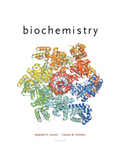
Concept explainers
Explaining the Stoichiometry of Fatty Acid Synthesis Carefully count and account for each of the atoms and charges in the equations for the synthesis of palmitoyl-CoA, the synthesis of malonyl-CoA, and the overall reaction for the synthesis of palmitoyl-CoA from acetyl-CoA.
Interpretation:
Each of the atoms and charges in the equations for the synthesis of palmitoyl CoA and the synthesis of malonyl CoA should be accounted and the overall reaction for the synthesis of palmitoyl CoA from Acetyl CoA should be discussed.
Concept Introduction:
The steps in the synthesis of palmitoyl CoA and the synthesis of malonyl CoA are as follows:
The overall reaction for the synthesis of palmitoyl CoA from acetyl CoA is,
Explanation of Solution
In the synthesis of malonyl CoA, the carbons in acetyl group of acetyl CoA is derived from glucose in glycolysis or side chains of amino acids. HCO3- is produced by reacting CO2 and H2O which is catalyzed by carbonic anhydrase. ADP and Pi are the products of ATP hydrolysis. A carbon from bicarbonate ion is incorporated into malonyl CoA while removing a water molecule.
In the synthesis of palmitoyl CoA, acetyl CoA and malonyl CoA is reacted each other and as a result CO2 is released. This CO2 is hydrated and subsequently ionized forming HCO3- ion. Therefore production of protons also occurs. This is why there is an amount protons with half of the amount of NADPH required present on left side of the equation. C-15 and C-16 of palmitoyl CoA are derived from acetyl CoA directly. Remaining carbons are derived indirectly from acetyl CoA via malonyl CoA.
Want to see more full solutions like this?
Chapter 24 Solutions
EBK BIOCHEMISTRY
- 1. Below is a template strand of DNA. Show the mRNA and protein that would result. label the ends of the molecules ( refer to attached image)arrow_forwardAttach the followina labels to the diagram below: helicase, single stranded binding proteins, lagging strand, leading strand, DNA polymerase, primase, 5' ends (3), 3' ends (3) (image attached)arrow_forward1. How much energy in terms of ATP can be obtained from tristearin (stearate is 18:0) Show steps pleasearrow_forward
- Multiple choice urgent!!arrow_forward1. Write the transamination reaction for alanine. Indicate what happens next to each of the molecules in the reaction, and under what conditions it happens. 2.arrow_forwardCH3 17. Which one of the compounds below is the HNO3 H2 1. NaNO2, HCI Br₂ 1. LiAlH4 major organic product H2SO4 Ni 2. CuCN, KCN FeBr3 2. H₂O, H+ obtained from the following series of reactions? CH3 toluene CH3 CH3 Br Br Br CH3 CH3 && Br Br NH₂ A NH₂ NH₂ B C NH₂ ΝΗΣ D Earrow_forward
- 13. Which one of the compounds below is the major organic product obtained from the following series of reactions? A + H2C=CH-CO Me heat (CH3)2NH 1. LiAlH4 2. H₂O ? 1,3-butadiene OH 'N' B C 14. Which one of the compounds below is the major organic product obtained from the following series of reactions? 'N' D 'N' E 1. XS CH3I 'N' 2. Ag₂O 3. H₂O, A A B с D E Narrow_forwardA NH2 NH2 B C H₂N. NH₂ D 5. The five compounds above all have molecular weights close to 75 g/mol. Which one has the highest boiling point? 6. The five compounds above all have molecular weights close to 75 g/mol. Which one has the lowest boiling point? E NH₂arrow_forward7. A solution of aniline in diethyl ether is added to a separatory funnel. Which ONE of the following aqueous solutions will remove aniline from the ether layer (and transfer it to the aqueous layer) if it is added to the separatory funnel and the funnel is shaken? A) aqueous NH3 B) aqueous Na2CO3 C) aqueous HCl D) aqueous NaOH E) aqueous CH3COONa (sodium acetate)arrow_forward
- 11. Which of the following choices is the best reagent to use to perform the following conversion? A) 1. LiAlH4 2. H₂O B) HCI, H₂O D) NaOH, H₂O E) Na№3 ? 'N' 'N' C) 1. CH3MgBr 2. HCI, H₂Oarrow_forwardNH2 ΝΗΣ NH₂ NH2 NH2 A OCH3 NO₂ B C D E 1. Which one of the five compounds above is the strongest base? 2. Which one of the five compounds above is the second-strongest base? (That is, which one is next-to-strongest base?) 3. Which one of the five compounds above is the weakest base? 4. Which one of the five compounds above is the second-weakest base? (That is, which one is next-to-weakest base?) NO2arrow_forwardDraw a diagram to demonstrate 3' to 5' exonuclease activity?arrow_forward
 BiochemistryBiochemistryISBN:9781305577206Author:Reginald H. Garrett, Charles M. GrishamPublisher:Cengage Learning
BiochemistryBiochemistryISBN:9781305577206Author:Reginald H. Garrett, Charles M. GrishamPublisher:Cengage Learning BiochemistryBiochemistryISBN:9781305961135Author:Mary K. Campbell, Shawn O. Farrell, Owen M. McDougalPublisher:Cengage Learning
BiochemistryBiochemistryISBN:9781305961135Author:Mary K. Campbell, Shawn O. Farrell, Owen M. McDougalPublisher:Cengage Learning

